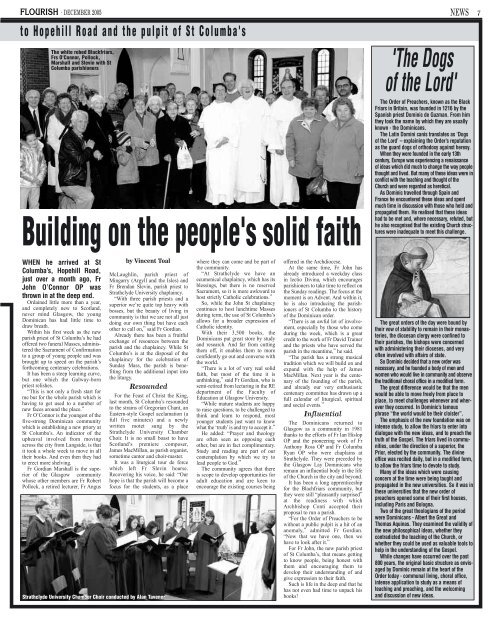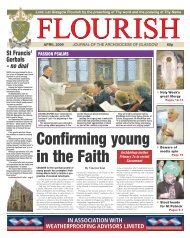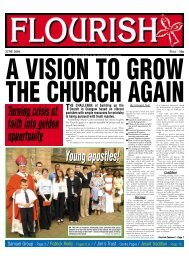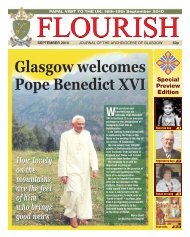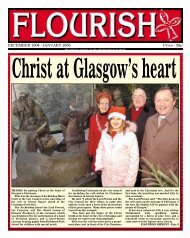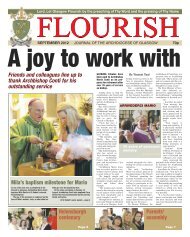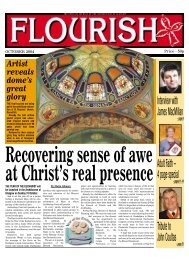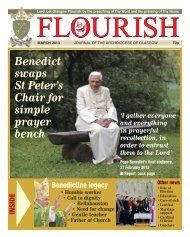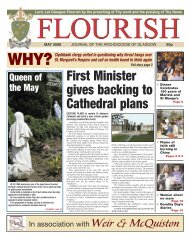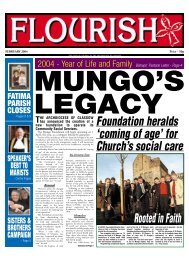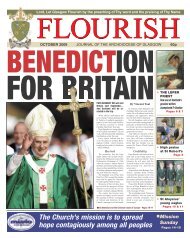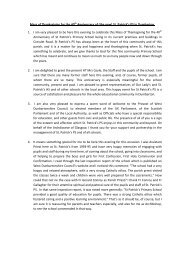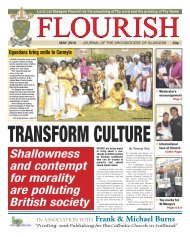December 2005 - Archdiocese of Glasgow
December 2005 - Archdiocese of Glasgow
December 2005 - Archdiocese of Glasgow
- No tags were found...
Create successful ePaper yourself
Turn your PDF publications into a flip-book with our unique Google optimized e-Paper software.
· DECEMBER <strong>2005</strong>to Hopehill Road and the pulpit <strong>of</strong> St Columba'sThe white robed Blackfriars,Frs O'Connor, Pollock,Marshall and Slevin with StColumba parishionersBuilding on the people's solid faith'The Dogs<strong>of</strong> the Lord'NEWS 7The Order <strong>of</strong> Preachers, known as the BlackFriars in Britain, was founded in 1216 by theSpanish priest Dominic de Guzman. From himthey took the name by which they are usuallyknown - the Dominicans.The Latin Domini canis translates as ‘Dogs<strong>of</strong> the Lord’ – explaining the Order’s reputationas the guard dogs <strong>of</strong> orthodoxy against heresy.When they were founded in the early 13thcentury, Europe was experiencing a renaissance<strong>of</strong> ideas which did much to change the way peoplethought and lived. But many <strong>of</strong> these ideas were inconflict with the teaching and thought <strong>of</strong> theChurch and were regarded as heretical.As Dominic travelled through Spain andFrance he encountered these ideas and spentmuch time in discussion with those who held andpropagated them. He realised that these ideashad to be met and, where necessary, refuted, buthe also recognised that the existing Church structureswere inadequate to meet this challenge.WHEN he arrived at StColumba’s, Hopehill Road,just over a month ago, FrJohn O’Connor OP wasthrown in at the deep end.Ordained little more than a year,and completely new to Scotland,never mind <strong>Glasgow</strong>, the youngDominican has had little time todraw breath.Within his first week as the newparish priest <strong>of</strong> St Columba’s he had<strong>of</strong>fered two funeral Masses, administeredthe Sacrament <strong>of</strong> Confirmationto a group <strong>of</strong> young people and wasbrought up to speed on the parish’sforthcoming centenary celebrations.It has been a steep learning curve,but one which the Galway-bornpriest relishes.“This is not only a fresh start forme but for the whole parish which ishaving to get used to a number <strong>of</strong>new faces around the place.”Fr O’Connor is the youngest <strong>of</strong> thefive-strong Dominican communitywhich is establishing a new priory atSt Columba’s. An indicator <strong>of</strong> theupheaval involved from movingacross the city from Langside, is thatit took a whole week to move in alltheir books. And even then they hadto erect more shelving.Fr Gordian Marshall is the superior<strong>of</strong> the <strong>Glasgow</strong> communitywhose other members are Fr RobertPollock, a retired lecturer, Fr Angusby Vincent ToalMcLaughlin, parish priest <strong>of</strong>Mingarry (Argyll and the Isles) andFr Brendan Slevin, parish priest toStrathclyde University chaplaincy.“With three parish priests and asuperior we’re quite top heavy withbosses, but the beauty <strong>of</strong> living incommunity is that we are not all justdoing our own thing but have eachother to call on,” said Fr Gordian.Already there has been a fruitfulexchange <strong>of</strong> resources between theparish and the chaplaincy. While StColumba’s is at the disposal <strong>of</strong> thechaplaincy for the celebration <strong>of</strong>Sunday Mass, the parish is benefitingfrom the additional input intothe liturgy.ResoundedFor the Feast <strong>of</strong> Christ the King,last month, St Columba’s resoundedto the strains <strong>of</strong> Gregorian Chant, anEastern-style Gospel acclamation (afull five minutes) and a newlywritten motet sung by theStrathclyde University ChamberChoir. It is no small boast to haveScotland’s premiere composer,James MacMillan, as parish organist,sometime cantor and choir-master.It was a liturgical tour de forcewhich left Fr Slevin hoarse.Recovering his voice, he said: “Ourhope is that the parish will become afocus for the students, as a placeStrathclyde University Chamber Choir conducted by Alan Tavenerwhere they can come and be part <strong>of</strong>the community.“At Strathclyde we have anecumenical chaplaincy, which has itsblessings, but there is no reservedSacrament, so it is more awkward tohost strictly Catholic celebrations.”So, while the John St chaplaincycontinues to host lunchtime Massesduring term, the use <strong>of</strong> St Columba’sallows for a broader expression <strong>of</strong>Catholic identity.With their 3,500 books, theDominicans put great store by studyand research. And far from cuttingthem <strong>of</strong>f, it enables them to moreconfidently go out and converse withthe world.“There is a lot <strong>of</strong> very real solidfaith, but most <strong>of</strong> the time it isunthinking,” said Fr Gordian, who issemi-retired from lecturing in the REdepartment <strong>of</strong> the Faculty <strong>of</strong>Education at <strong>Glasgow</strong> University.“While mature students are happyto raise questions, to be challenged tothink and learn to respond, mostyounger students just want to knowwhat the ‘truth’ is and try to accept it.”He added: “Prayer and theologyare <strong>of</strong>ten seen as opposing eachother, but are in fact complimentary.Study and reading are part <strong>of</strong> ourcontemplation by which we try tolead people to God.”The community agrees that thereis scope to develop opportunities foradult education and are keen toencourage the existing courses being<strong>of</strong>fered in the <strong>Archdiocese</strong>.At the same time, Fr John hasalready introduced a weekday classin lectio Divina, which encouragesparishioners to take time to reflect onthe Sunday readings. The focus at themoment is on Advent. And within it,he is also introducing the parishioners<strong>of</strong> St Columba to the history<strong>of</strong> the Dominican order.“There is an awful lot <strong>of</strong> involvement,especially by those who comeduring the week, which is a greatcredit to the work <strong>of</strong> Fr David Trainerand the priests who have served theparish in the meantime,” he said.“The parish has a strong musicaltradition which we will build on andexpand with the help <strong>of</strong> JamesMacMillan. Next year is the centenary<strong>of</strong> the founding <strong>of</strong> the parish,and already our very enthusiasticcentenary committee has drawn up afull calendar <strong>of</strong> liturgical, spiritualand social events.”InfluentialThe Dominicans returned to<strong>Glasgow</strong> as a community in 1981thanks to the efforts <strong>of</strong> Fr Ian HislopOP and the pioneering work <strong>of</strong> FrAnthony Ross OP and Fr ColumbaRyan OP who were chaplains atStrathclyde. They were preceded bythe <strong>Glasgow</strong> Lay Dominicans whoremain an influential body in the life<strong>of</strong> the Church in the city and beyond.It has been a long apprenticeshipfor the Blachfriars community, butthey were still “pleasantly surprised”at the readiness with whichArchbishop Conti accepted theirproposal to run a parish.“For the Order <strong>of</strong> Preachers to bewithout a public pulpit is a hit <strong>of</strong> ananomaly,” admitted Fr Gordian.“Now that we have one, then wehave to look after it.”For Fr John, the new parish priest<strong>of</strong> St Columba’s, that means gettingto know people, being honest withthem and encouraging them todevelop their understanding <strong>of</strong> andgive expression to their faith.Such is life in the deep end that hehas not even had time to unpack hisbooks!The great orders <strong>of</strong> the day were bound bytheir vow <strong>of</strong> stability to remain in their monasteries,the diocesan clergy were confined totheir parishes, the bishops were concernedwith administering their dioceses, and very<strong>of</strong>ten involved with affairs <strong>of</strong> state.So Dominic decided that a new order wasnecessary, and he founded a body <strong>of</strong> men andwomen who would live in community and observethe traditional choral <strong>of</strong>fice in a modified form.The great difference would be that the menwould be able to move freely from place toplace, to meet challenges whenever and whereverthey occurred. In Dominic’s famousphrase “the world would be their cloister”.The emphasis <strong>of</strong> the new foundation was onintense study, to allow the friars to enter intodialogue with the new ideas, and to preach thetruth <strong>of</strong> the Gospel. The friars lived in communities,under the direction <strong>of</strong> a superior, thePrior, elected by the community. The divine<strong>of</strong>fice was recited daily, but in a modified form,to allow the friars time to devote to study.Many <strong>of</strong> the ideas which were causingconcern at the time were being taught andpropagated in the new universities. So it was inthese universities that the new order <strong>of</strong>preachers opened some <strong>of</strong> their first houses,including Paris and Bologna.Two <strong>of</strong> the great theologians <strong>of</strong> the periodwere Dominicans - Albert the Great andThomas Aquinas. They examined the validity <strong>of</strong>the new philosophical ideas, whether theycontradicted the teaching <strong>of</strong> the Church, orwhether they could be used as valuable tools tohelp in the understanding <strong>of</strong> the Gospel.While changes have occurred over the past800 years, the original basic structure as envisagedby Dominic remain at the heart <strong>of</strong> theOrder today - communal living, choral <strong>of</strong>fice,intense application to study as a means <strong>of</strong>teaching and preaching, and the welcomingand discussion <strong>of</strong> new ideas.


